Mastagi Rumi – Mastic – Health Benefits
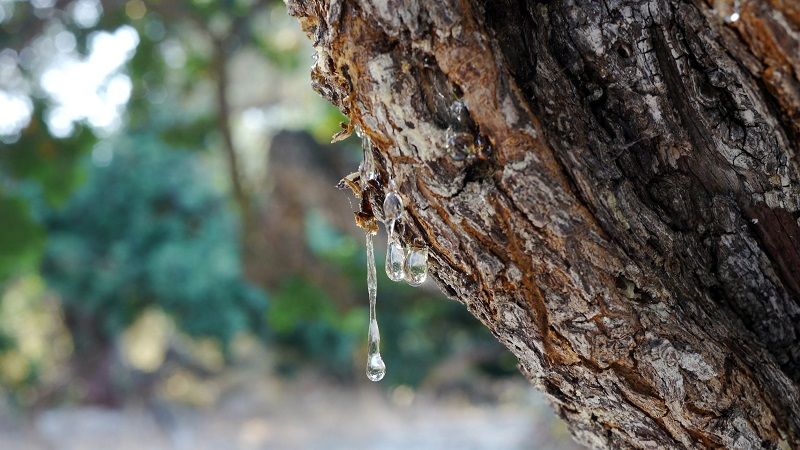
Mastic gum (also called Mastagi Roomi) is plant resin (sap) from the trunk of Pistacia Lentiscus. In Ayurveda and Unani medicine, it is widely used for its ulcer healing, antispasmodic and aphrodisiac action. It reduces menstrual pains and muscular pains. It is useful for the treatment of heartburn, gastritis, ulcers and indigestion.
Botanical Classification (Plant Taxonomy)
| Kingdom | PLANTAE |
| Sub-Kingdom | VIRIDIPLANTAE |
| Infra Kingdom | STREPTOPHYTA (land plants) |
| Super Division | EMBRYOPHYTA |
| Division | TRACHEOPHYTA (TRACHEOPHYTES or Vascular Plants) |
| Sub Division | SPERMATOPHYTINA (SPERMATOPHYTES or Seed Plants) |
| Class | MAGNOLIOPSIDA |
| Super Order | ROSANAE |
| Order | SAPINDALES |
| Family | ANACARDIACEAE (Cashews Family) |
| Genus | PISTACIA (PISTACHE) |
| Species | PISTACIA LENTISCUS (Mastic Tree) |
Medicinal Parts
Mastic Gum (also called Mastagi Roomi or Mastagi Rumi) is used in preparing medicines and for therapeutic uses. It is collected from the trunk of Pistacia Lentiscus (Mastic Tree). Mastic Gum is light yellow in color and it has light sweet taste and sweet fragrance.
Phytochemistry (Chemical Composition)
Mastic Gum contains essential oils about 1 to 3%. The other active principle is MASTICONIC ACID. The following active components are also found in Mastic Gum and mastic oil.
Major Components
- ALPHA-PINENE
- BETA-CARYOPHYLLENE
- BETA-MYRCENE
- BETA-PINENE
- LIMONEN
Traces Components
- ALPHA-TERPINEOL
- LINALOOL
- VERBENONE
Antibacterial activity is possibly due to traces components. The significant antimicrobial activity is observed with mastic oil on Bacillus subtilis, Escherichia coli and Staphylococcus Aureus. All components appear to be working synergistically for antibacterial and antifungal characteristics of the mastic gum and mastic oil.
Medicinal Properties
Mastic Gum has following healing properties.
- Antacid
- Anti-ulcer
- Anti-inflammatory (appears on gastrointestinal tract)
- Demulcent (Emollient)
- Digestive Stimulant
- Antispasmodic (effect appears in membranous dysmenorrhea)
- Aphrodisiac
- Emmenagogue (promotes menstrual discharge)
- Muscle relaxant
- Adaptogenic
- Carminative
- Digestive stimulant
- Astringent
- Liver stimulant
- Diuretic
- Analgesic
- Mild antitussive
Ayurvedic Properties
| Taste |
(Sweet) & (Astringent) |
| Main Quality |
(Light) (Dry) |
| Potency |
(Hot) |
| Resultant |
(Sweet) |
| Therapeutic Effect |
|
| (Effect on Humors) | Pacifies and Detoxifies |
| Effects on Organs | Stomach, Intestines, Reproductive Organs |
Therapeutic Indications
Mastic gum is helpful in following health conditions.
- Heartburn & Indigestion
- Loss of appetite (mostly when associated with gastritis)
- Peptic & duodenal ulcer
- Gastritis
- Gastroesophageal Reflux Disease (GERD)
- Inflammatory Bowel Syndrome
- Ulcerative Colitis
- Dysuria
- Breathing troubles
- Dysmenorrhea
- Amenorrhea
- Bad breath
- Excessive salivation
- Sluggish Liver
- Seminal Weakness
- Early Discharge
- Erectile Dysfunction
Benefits & Medicinal Uses
Mastic gum is found in Unani medicinal formulations, which Dysuria, excessive salivation, ulcer, backache, etc.
Key Benefits of Mastic Gum
- Mastic Gum provides strength to the stomach and intestines. It makes a protective layer on the linings of the stomach, which protects from hyperacidity.
- Appetite stimulant action increases appetite.
- Carminative action provides relief from flatulence and abdominal distension.
- In general, it is a health tonic and helps in general debility when used with Ashwagandha.
Bad Breath (Halitosis)
Mastic gum is an effective treatment for bad breath. Chewing mastic gum helps freshening up the breath and removes bad mouth odor.
The antimicrobial action of Mastic gum reduces microbes in the mouth responsible for bad breath. Most bacteria grow in the mouth due to the breakdown of food particles in the mouth. This reaction produces foul odor in the mouth. The second most cause is poor dental hygiene.
Chewing Mastic gum removes food particles, inhibits growth of bacteria due to antibacterial action and clears up the teeth, which ultimately reduces bad breath and makes oneself feeling fresh again.
Dental Plaque
Dried mastic gum powder is useful for removing dental plaque naturally. Mastic gum toothpowder also strengthens the gums and teeth, which helps preventing early tooth loss.
The following toothpowder helps prevent all types of dental problems and cures bad breath, pyorrhea, toothache and yellowness of teeth.
| Ingredients | Quantity in Percentage (%) |
| Dried mastic gum powder | 20% |
| Neem Inner Bark Powder | 20% |
| Babul Gum Powder (GUM ARABIC) | 20% |
| Jamun bark – Syzygium Jambolanum | 20% |
| Laung (Cloves) powder | 5% |
| Mulethi – Licorice – Glycyrrhiza Glabra | 5% |
Heartburn & Indigestion
Mastic gum appears to reduce the gastric acid in the stomach. Generally, 500 mg mastic gum is used with 1000 mg licorice powder to get immediate relief from the heartburn.
In ayurveda, in addition to mastic gum and licorice, Amla and Praval Pishti and Mukta Pishti are added to increase the effectiveness of the Heartburn and Indigestion treatment. 2 to 4 weeks therapy with this combination cures indigestion (dyspepsia) and heartburn.
Chronic Gastritis
Mastic gum has mild anti-inflammatory action on stomach linings. To increase its anti-inflammatory action, it is used in combination with licorice and Vanshlochan (Bamboo Manna).
GERD
Gastroesophageal Reflux (GERD) is actually caused by the weakness of the lower esophageal sphincter valve, which cause acid reflux. In such case, mastic gum is very useful for providing strength to the valves. Further, it also has antacid action, which reduces symptoms of GERD.
Peptic & Duodenal Ulcer
Mastic gum powder fights off Helicobacter Pylori, ulcer-causing bacteria. It has potential inhibiting and bacteriolytic action against H. Pylori. Recent studies have shown Mastic gum effectiveness in stomach as well as intestinal ulcers.
Mastic gum is also effective in other causes of ulcer, which may include use of NSAIDs and other medicines that may result in erosion of gastric or intestinal mucosa. Mastic gum builds a protective layer on linings of stomach and intestines, which prevents and treats ulcers.
However, mastic gum alone works well in curing ulcers, but adding licorice and Amla, and Vanshlochan (Bamboo Manna) speeds up recovery. The following mastic gum combination is more helpful in peptic and duodenal ulcers.
| Ingredients | Quantity * |
| (مصطگی) Mastic gum powder | 500 mg |
| (ملٹھی) Licorice powder | 500 mg |
| (آملہ) Amla powder | 500 mg |
| Tabasheer (تباشیر) (Bamboo Manna) | 500 mg |
| (Munga مونگا) Coral Calcium | 500 mg |
* Quantity is for a single dose. This combination can be taken thrice a day for maximum benefits. The recommended therapy duration with this combination in ulcer is about 8 weeks. It heals ulcer, prevents recurrence and reduces ulcer symptoms and abdominal pain.
Ulcerative Colitis
Mastic gum is a potent alternative medicine for ulcerative colitis. 3 to 6 months therapy with Mastic gum alleviates all symptoms of ulcerative colitis. For more results, the following Mastic combination is helpful.
| Ingredients | Quantity * |
| (مصطگی رومی پاؤڈر) Mastic gum powder | 500 mg |
| (ملٹھی پاؤڈر) Licorice powder | 1000 mg |
| (ست گلو) Giloy Sat | 500 mg |
| Tabasheer (تباشیر) (Bamboo Manna) | 500 mg |
| Kushta Marjan (کشتہ مرجان) Coral | 500 mg |
| Kushta Moti (کشتہ سچے موتی) Pearl | 125 mg |
| Kushta Jist (کشتہ جست) Zinc | 10 mg |
* Quantity is for a single dose. This mastic gum combination can be taken twice or thrice a day for at least 3 months.
Bed Wetting (Enuresis)
Mastic gum with Gum Acacia and Hajrul Yahood is beneficial for children suffering with bed-wetting or enuresis.
Urinary Incontinence
The same formulation containing mastic gum and gum acacia and Shilajit or Chandraprabha Vati strengthens urinary bladder, reduces incontinence and decreases frequency or urination.
Dosage & Administration
The general dosage of mastic (Pistacia Lentiscus) gum or Mastagi Roomi is as follows:
| Age Group | Dosage |
| Infants (0 to 1 years) | 10 mg per Kg body weight * |
| Children (1 to 5 years) | 125 mg to 250 mg * |
| Children (6 to 10 years) | 250 mg to 500 mg * |
| Children (Above 10 years) | 375 mg to 1000 mg * |
| Adults | 500 mg to 1000 mg * |
| Geriatric Patients | 500 mg to 1000 mg |
Dose Adjustments
| Minimum Effective Dosage | 125 mg * |
| Maximum Possible Dosage | 6000 mg (6 grams) ** |
* Twice a day ** Total Daily Dosage in Divided Doses
The maximum dosage of mastic gum should not exceed from 6 grams in a 24-hour period.
How to Take
Mastic gum can be taken alone with warm water. In ayurvedic and Unani medicine, it is used with other herbs and some of these combinations are provided in Benefits & Medicinal Uses Section of this article.
Recommended Treatment Duration
The recommended treatment duration with mastic gum ranges from a minimum of 2 weeks month to a maximum of 6 months.
Safety Profile
Mastic gum is POSSIBLY SAFE & TOLERABLE in most people within the therapeutic dosage of Mastic gum.
Side Effects
Unani and ayurvedic ancient texts believe mastic gum is not suitable for kidneys. The extract form or principle alkaloid and mastic oil are more likely to cause the side effects. Mastic gum excessive use in higher dosage exceeding 4 grams per day may also cause following side effects.
- Constipation (common)
- Diarrhea (Common with higher dosage, less common with moderate dosage) – mostly reported in children
- Nausea (uncommon)
- Burping (uncommon)
- Blood in the urine (very rare)
If blood appears in the urine due to mastic gum, then antidote of mastic gum should be used.
Antidote of Mastic Gum
Myrtus Communis (Myrtle) – Vilayati Mehndi – Leaves juice should be used to treat blood in the urine due to mastic gum.
Toxicity & Allergic Reaction
Mastic gum allergy is uncommon, but allergic reaction with mastic can result in following symptoms:
- Loose stools or diarrhea
- Swelling of the tongue, mouth or face
- Itching
Pregnancy & Breastfeeding
The reliable information about the safety of mastic gum in pregnancy and breastfeeding is not available. Therefore, it is better to avoid mastic gum use in such case.
Contraindications
As per ayurveda and Unani medicine, mastic gum should not be used in following diseases.
- Acute or chronic renal failure
- Nephrotic syndrome
- Other kidney diseases
www.ayurtimes.com
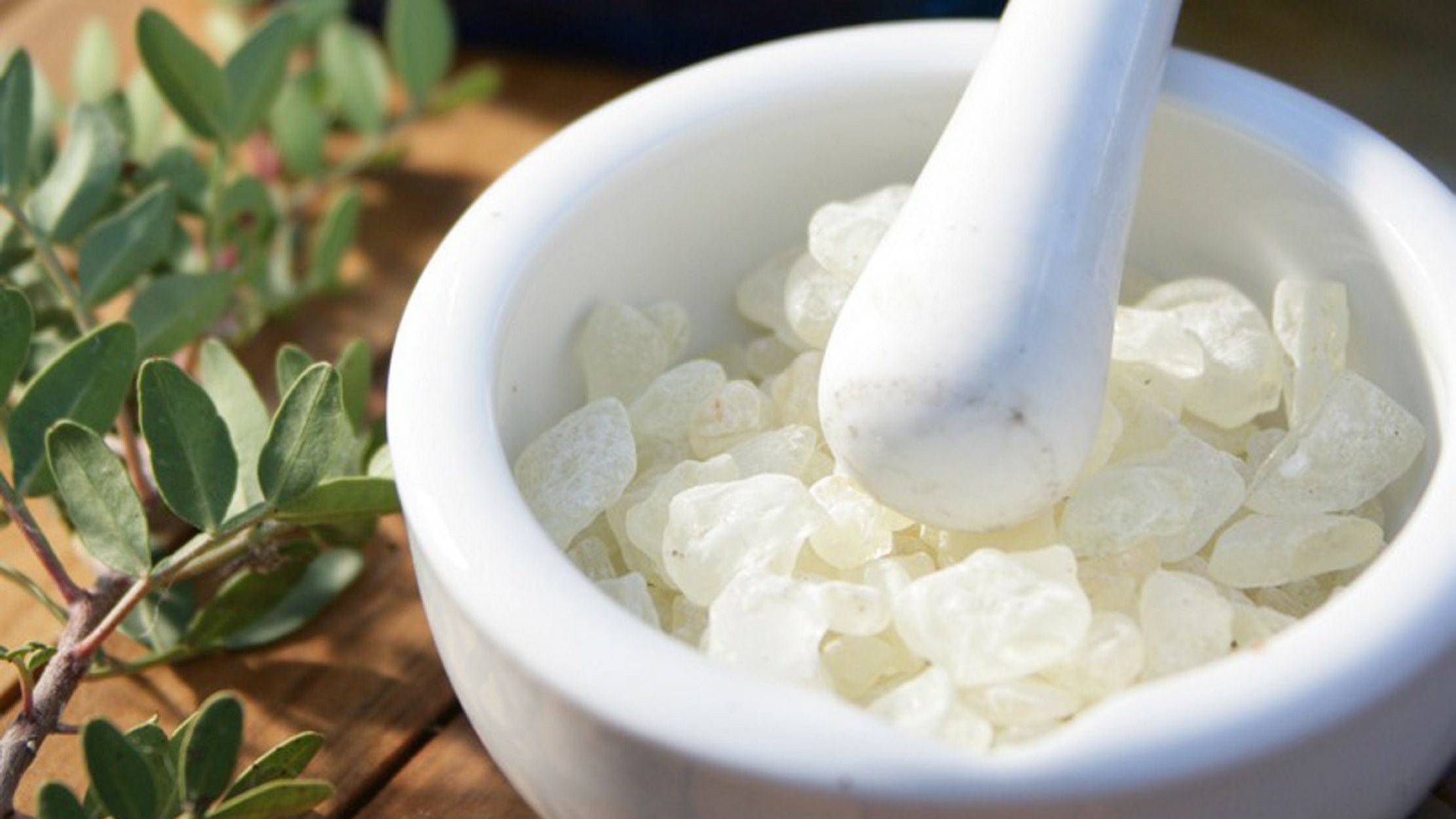
Mastagi Rumi – Mastic – مصطگی رومی – مصطكى
ماہیت ۔ مصطگی جماہوا رال دار مادہ ہے جو ایک درخت پس ٹالیالین ٹس کس کا گوند ہے جو کے تنے اور موٹی شاخوں میں شگاف دینے سے حاصل ہوتی ہے ۔ ایک اچھے درخت سے دس بارہ پونڈ مصطگی حاصل ہوتی ہے ۔ مصطگی کے چھوٹے گول بے قاعدہ دانے مختلف شکلوں کے ہوتے ہیں اس کی رنگت زرد مائل شفاف ذائقہ معمولی شیریں خوشبودار ہے ۔منہ میں چبانے سے ملائم مگر چپچپا سا ہوتاہے ۔ یہ پانی میں حل پذیر نہیں الکوحل ایتھر اور کلوروفارم میں حل ہوجاتی ہے۔
مقام پیدائش ۔ اس کے درخت مغربی افریقہ اور یونان کے قدیم جزیروں میں پیداہوتے ہیں بحیرہ روم وغیرہ ۔
نقلی مصطگی ۔ درخت پس ٹاسیاٹیری بن تھس کی رال دار گوند ہے اس کی بو گندہ بہروزہ جیسی ہوتی ہے۔ اسے خنجک یا کابلی مصطگی کہتے ہیں ۔ اسی لئے بعض لوگ بہروزہ خشک کرکے بھی نقلی مصطگی تیارکرلیتے ہیں ۔ یہ کھرل آسانی سے ہوجاتی ہے۔اور ہاتھ میں دبانے سے ریزہ ریزہ ہوجاتی ہے۔ اصلی مصطگی کو زور سے رگڑا جائے تو باریک ہونے کی بجائے چمٹ جاتی ہے ۔ اور گرم ہوکر سخت ہوتی ہے۔اس لئے ہلکے ہاتھ اور ٹھنڈے کھرل میں باریک ہوجاتی ہے۔
مزاج ۔ گرم خشک ۔درجہ دوم ۔
افعال ۔ مقوی معدہ وجگر ، کاسرریاح ، ملین باقبض ، منفث بلغم ، ملطف محلل اورام ، جاذب رطوبات جالی حابس الدم مسہل اخلاط
استعمال ۔ مقوی معدہ ہونے کی وجہ سے ضعف معدہ اور کاسرریاح ہونے کی وجہ سے ریاح کو تحلیل کرتی ہے۔ مصطگی بھوک بڑھاتی ہے معدہ جگر اور قوت ہاضمہ کوقوت دیتی ہے۔ بغرض تلین گل قند کے ساتھ ملاکر کھاتے ہیں جاذب رطوبت ہونے کی وجہ سے نسیان میں استعمال کراتے ہیں کیونکہ یہ رطوبت دماغ کو جذب کرتی ہے۔ قابض و حابس ہونے کی وجہ سے کھانسی اور قصبہ الریہ کے تصیفہ کے لئے استعمال کرتے ہیں ۔غاریقون کے ساتھ مسہل بلغم ایلوا کے ساتھ مسہل صفرا اور ہلیلہ جات کے ساتھ مسہل سودا ہے سردی کی وجہ سے باربار پیشاب آنے اور بول الفراش کو مفیدہے۔
مسہل ادویہ کی اصلاح یا تیزی کو کم کرنے کے لئے اس میں مصطگی رومی شامل کرتے ہیں مسہل ادویہ کے تیزی کم ہونے کے ساتھ آمعاء میں خراش بھی پیدا نہیں ہوتی ۔
استعمال بیرونی ۔ محلل ہونے کی وجہ سے ورموں کو تحلیل کرنے کے لئے ضمادوں میں شامل کرتے ہیں جالی ہونے کی وجہ سے ابٹن میں شامل کرکے چہرہ پر ملتے ہیں یہ چہرہ رنگ کو نکھارتاہے ۔ اس کا منجن دانتوں اورمسوڑھوں کو مضبوط کرتاہے ۔
فوائد خاص ۔ مقوی معدہ ،حابس۔
مضر۔ امراض مقعد۔بول الدم پیداکرتاہے۔
مصلح ۔ سرکہ و آب مورد ۔
بدل ۔ پودینہ
مقدارخوراک ۔ ایک سے دو گرام یا ماشے ۔


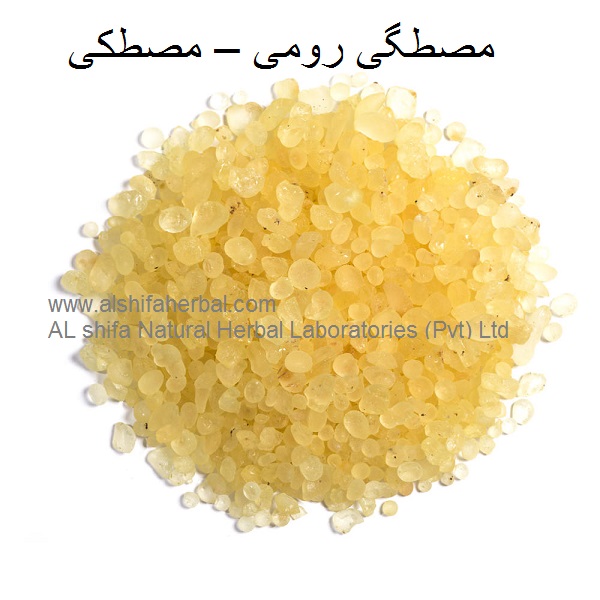
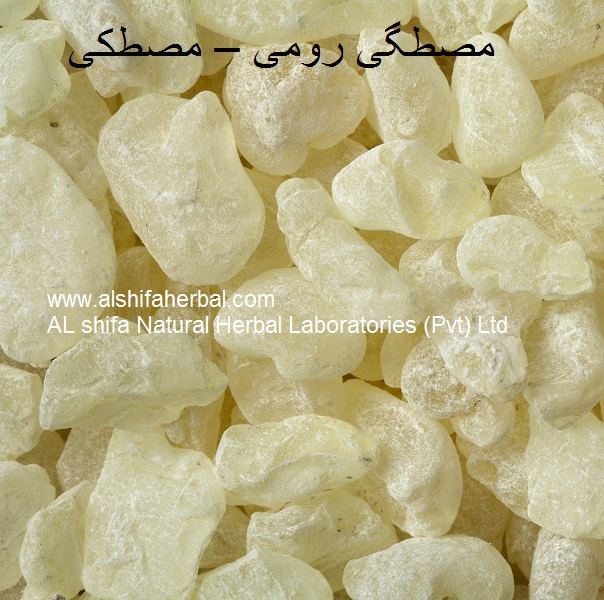
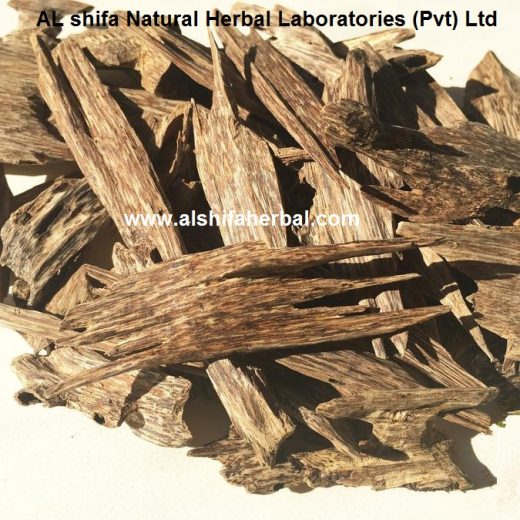
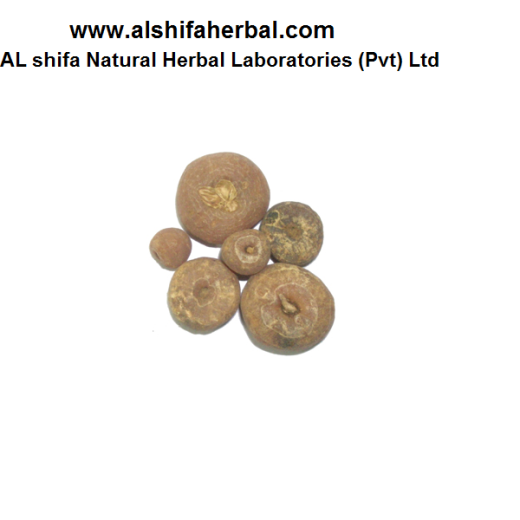
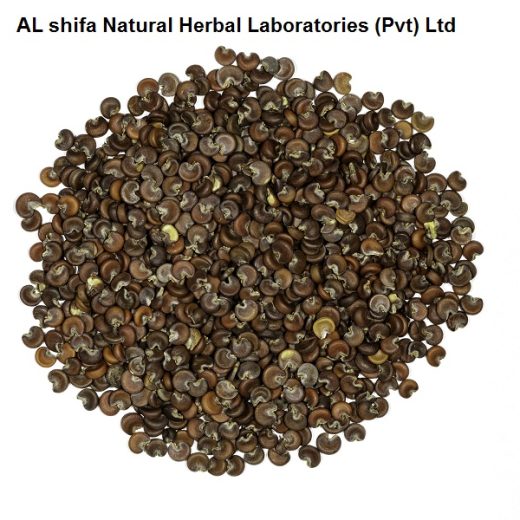



Reviews
There are no reviews yet.